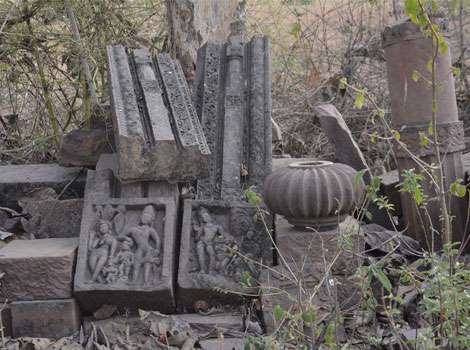June 24, 2015
BHOPAL, MADHYA PRADESH – In a major addition to the heritage treasure trove of Madhya Pradesh, the state directorate of archaeology has discovered remains of over 1,500-old temples and residential structures on Kaimur hills in Maihar (Satna district), about 480km northeast of Bhopal.

June 24, 2015
BHOPAL, MADHYA PRADESH – In a major addition to the heritage treasure trove of Madhya Pradesh, the state directorate of archaeology has discovered remains of over 1,500-old temples and residential structures on Kaimur hills in Maihar (Satna district), about 480km northeast of Bhopal.

Some of the remains of a temple belong to early Gupta period in Satna.
According to experts, the remains belong to early Gupta period (4th-5th century AD) and are indicative of a major ancient settlement in the area.
“Remains of two Shiva temples and two house plans were discovered in four of the six mounds excavated in village Manora, about 50km from Satna district headquarters. There are in all 99 surveyed mounds in the area and there is likelihood of further discoveries,” commissioner of archaeology, archives and museums, Ajatshatru told HT.
The excavation work was done with the support of prominent archaeologist Pramod Dandwate of Deccan College, Pune, he said.
The Gupta Empire had flourished in the north-central India between 320 and 550 AD. Remnants of the period have been made in different parts of the state, including Udaigiri in Vidisha district that has one of the earliest Gupta temple, world heritage site Sanchi (Raisen), Nachna (Panna district), Bhumra (Satna) and others. The latest discovery adds to the evidences of the great empire.
The remains have been discovered over a period of last two months in village Manora have all the tell-tale early Gupta period indications — simple architecture and decorations, curly hairstyle of the figurines of Gods and Goddesses, big molded bricks, red terracotta pottery, stone and iron household utensils and so on, deputy director (excavation) DK Mathur who is leading the excavation team, said.
Among the interesting discoveries were an in-situ Shivalinga in the remains of a temple with unique structural design. “The excavation indicates that the base of the temple was square in shape and the structure over it was octagonal. The boundary area was round. We also found an in-site water drainage structure (Jalahari) at the site, locally known as Talaiya ka Tila,” Mathur said.
Also lot of iron nails and an iron clamp were found near the temple. House remains with wooden doors were also found. Two stone niches with simplistic decoration — typical of Gupta period — were discovered near the temple remains.
Metal weapons and implements like spear, arrows, crowbar, big spoons, stone grinding implements, flour mills, parts of stone jewelry, dancing male figure, mica-mixed pottery and others were found in abundance in the area.
The official said the site with 99 surveyed mounds holds promise of even more interesting discoveries and the directorate would be seeking permission from the Archaeological Survey of India for further excavation.
Gold lure
The deputy director DK Mathur told HT that his team found big holes dug into almost all of the 99 mounds in the area, some of them almost 50 years old. This is probably due to the local lore that the mounds hold ancient treasure, especially gold.
“The excavation till now suggests a flourishing Gupta period settlement and it might not be surprising if we find gold coins that were prevalent at time. But the earlier diggers were not successful I suppose,” he said.
Courtesy: HT

















































































































